Dynamic Behavior of Magnetically Affected Rod-Like Nanostructures with Multiple Defects via Nonlocal-Integral/Differential-Based Models
Abstract
1. Introduction
2. Establishing an NDSM for the Magnetically Affected Defected Nanorods
2.1. Problem Delineation
2.2. Construction of Nonlocal-Differential-Surface-Based Governing Equations
2.2.1. Preliminaries
2.2.2. Classical Axial Force within a Magnetically Influenced Nanorod
2.3. Equations of Motion Associated with the NDSM
2.4. Frequency Analysis via a Semi-Analytical Methodology
3. Establishing an NISM for the Magnetically Affected Defected Nanorods
3.1. Governing Equations Associated with the NISM
3.2. Frequency Analysis via FEM
4. Results and Discussion
4.1. Several Comparison Studies
4.1.1. A Particular Verification Study
4.1.2. NDSM vs. NISM
4.2. Effect of the Nonlocality
4.3. Effect of the Defect’s Location
4.4. Effect of the Nanorod’s Diameter
4.5. Effect of the Magnetic Field Strength
4.6. Effect of the Number of Defects
5. Conclusions
Author Contributions
Funding
Conflicts of Interest
Appendix A. The Elements of the L Matrix
Appendix B. Frequencies and Vibration Modes of a Magnetically Affected Nanorod with a Single Defect
Appendix B.1. FIFI Boundary Conditions
Appendix B.2. FIFR Boundary Conditions
References
- Robinson, R.D.; Sadtler, B.; Demchenko, D.O.; Erdonmez, C.K.; Wang, L.W.; Alivisatos, A.P. Spontaneous superlattice formation in nanorods through partial cation exchange. Science 2007, 317, 355–358. [Google Scholar] [CrossRef] [PubMed]
- Luther, J.M.; Zheng, H.; Sadtler, B.; Alivisatos, A.P. Synthesis of PbS nanorods and other ionic nanocrystals of complex morphology by sequential cation exchange reactions. J. Am. Chem. Soc. 2009, 131, 16851–16857. [Google Scholar] [CrossRef] [PubMed]
- Sadtler, B.; Demchenko, D.O.; Zheng, H.; Hughes, S.M.; Merkle, M.G.; Dahmen, U.; Wang, L.W.; Alivisatos, A.P. Selective facet reactivity during cation exchange in cadmium sulfide nanorods. J. Am. Chem. Soc. 2009, 131, 5285–5293. [Google Scholar] [CrossRef] [PubMed]
- Polsongkram, D.; Chamninok, P.; Pukird, S.; Chow, L.; Lupan, O.; Chai, G.; Khallaf, H.; Park, S.; Schulte, A. Effect of synthesis conditions on the growth of ZnO nanorods via hydrothermal method. Phys. B 2008, 403, 3713–3717. [Google Scholar] [CrossRef]
- Tam, K.H.; Djurisˇic, A.B.; Chan, C.M.; Xi, Y.Y.; Tse, C.W.; Leung, Y.H.; Chan, W.K.; Leung, F.C.; Au, D.W. Antibacterial activity of ZnO nanorods prepared by a hydrothermal method. Thin Solid Film. 2008, 516, 6167–6174. [Google Scholar] [CrossRef]
- Norris, B.J.; Anderson, J.; Wager, J.F.; Keszler, D.A. Spin–coated zinc oxide transparent transistors. J. Phys. D Appl. Phys. 2003, 36, L105. [Google Scholar] [CrossRef]
- Cunningham, P.D.; Souza, J.B., Jr.; Fedin, I.; She, C.; Lee, B.; Talapin, D.V. Assessment of anisotropic semiconductor nanorod and nanoplatelet heterostructures with polarized emission for liquid crystal display technology. ACS Nano 2016, 10, 5769–5781. [Google Scholar] [CrossRef]
- Hughes, M.P. AC electrokinetics: Applications for nanotechnology. Nanotechnology 2000, 11, 124. [Google Scholar] [CrossRef]
- Wang, Z.L. Zinc oxide nanostructures: Growth, properties and applications. J. Phys.Condens. Mat. 2004, 16, R829. [Google Scholar] [CrossRef]
- Yi, G.C.; Wang, C.; Park, W.I. ZnO nanorods: Synthesis, characterization and applications. Semicond. Sci. Technol. 2005, 20, S22. [Google Scholar] [CrossRef]
- Lewis, J.; Zhang, J.; Jiang, X. Fabrication of organic solar array for applications in microelectromechanical systems. J. Renew. Sustain. Energy 2009, 1, 013101. [Google Scholar] [CrossRef]
- Huang, X.; El-Sayed, I.H.; Qian, W.; El-Sayed, M.A. Cancer cell imaging and photothermal therapy in the near-infrared region by using gold nanorods. J. Am. Chem. Soc. 2006, 128, 2115–2120. [Google Scholar] [CrossRef] [PubMed]
- Wang, L.; Liu, Y.; Li, W.; Jiang, X.; Ji, Y.; Wu, X.; Xu, L.; Qiu, Y.; Zhao, K.; Wei, T.; et al. Selective targeting of gold nanorods at the mitochondria of cancer cells: Implications for cancer therapy. Nano Lett. 2010, 11, 772–780. [Google Scholar] [CrossRef] [PubMed]
- Briscoe, J.; Stewart, M.; Vopson, M.; Cain, M.; Weaver, P.M.; Dunn, S. Nanostructured p-n junctions for kinetic-to-electrical energy conversion. Adv. Energy Mater. 2012, 2, 1261–1268. [Google Scholar] [CrossRef]
- Kumar, B.; Kim, S.W. Energy harvesting based on semiconducting piezoelectric ZnO nanostructures. Nano Energy 2012, 1, 342–355. [Google Scholar] [CrossRef]
- Park, S.H.; Kim, S.H.; Han, S.W. Growth of homoepitaxial ZnO film on ZnO nanorods and light emitting diode applications. Nanotechnology 2007, 18, 055608. [Google Scholar] [CrossRef]
- Willander, M.; Nur, O.; Zhao, Q.X.; Yang, L.L.; Lorenz, M.; Cao, B.Q.; Pe´rez, J.Z.; Czekalla, C.; Zimmermann, G.; Grundmann, M.; et al. Zinc oxide nanorod based photonic devices: Recent progress in growth, light emitting diodes and lasers. Nanotechnology 2009, 20, 332001. [Google Scholar] [CrossRef]
- Anandan, S.; Wen, X.; Yang, S. Room temperature growth of CuO nanorod arrays on copper and their application as a cathode in dye-sensitized solar cells. Mater. Chem. Phys. 2005, 93, 35–40. [Google Scholar] [CrossRef]
- Fujihara, K.; Kumar, A.; Jose, R.; Ramakrishna, S.; Uchida, S. Spray deposition of electrospun TiO2 nanorods for dye–sensitized solar cell. Nanotechnology 2007, 18, 365709. [Google Scholar] [CrossRef]
- Liu, B.; Aydil, E.S. Growth of oriented single–crystalline rutile TiO2 nanorods on transparent conducting substrates for dye–sensitized solar cells. J. Am. Chem. Soc. 2009, 131, 3985–3990. [Google Scholar] [CrossRef]
- Eringen, A.C. Nonlocal polar elastic continua. Int. J. Eng. Sci. 1972, 10, 1–16. [Google Scholar] [CrossRef]
- Eringen, A.C. Nonlocal Continuum Field Theories; Springer: New York, NY, USA, 2002. [Google Scholar]
- Aydogdu, M. Axial vibration of the nanorods with the nonlocal continuum rod model. Physica E 2009, 41, 861–864. [Google Scholar] [CrossRef]
- Narendar, S.; Gopalakrishnan, S. Nonlocal scale effects on ultrasonic wave characteristics of nanorods. Physica E 2010, 42, 1601–1604. [Google Scholar] [CrossRef]
- Simsek, M. Nonlocal effects in the free longitudinal vibration of axially functionally graded tapered nanorods. Comput. Mater. Sci. 2012, 61, 257–265. [Google Scholar] [CrossRef]
- Aydogdu, M. Longitudinal wave propagation in nanorods using a general nonlocal unimodal rod theory and calibration of nonlocal parameter with lattice dynamics. Int. J. Eng. Sci. 2012, 56, 17–28. [Google Scholar] [CrossRef]
- Adhikari, S.; Murmu, T.; McCarthy, M.A. Dynamic finite element analysis of axially vibrating nonlocal rods. Finite Elem. Anal. Des. 2013, 63, 42–50. [Google Scholar] [CrossRef]
- Kiani, K. Nonlocal-integro-differential modeling of vibration of elastically supported nanorods. Physica E 2016, 83, 151–163. [Google Scholar] [CrossRef]
- Wang, C.M.; Zhang, Y.Y.; Ramesh, S.S.; Kitipornchai, S. Buckling analysis of micro–and nano-rods/tubes based on nonlocal Timoshenko beam theory. J. Phys. D Appl. Phys. 2006, 39, 3904. [Google Scholar] [CrossRef]
- Thai, H.T. A nonlocal beam theory for bending, buckling, and vibration of nanobeams. Int. J. Eng. Sci. 2012, 52, 56–64. [Google Scholar] [CrossRef]
- Ke, L.L.; Wang, Y.S. Thermoelectric-mechanical vibration of piezoelectric nanobeams based on the nonlocal theory. Smart Mater. Struct. 2012, 21, 025018. [Google Scholar] [CrossRef]
- Simsek, M.; Yurtcu, H.H. Analytical solutions for bending and buckling of functionally graded nanobeams based on the nonlocal Timoshenko beam theory. Compos. Struct. 2013, 97, 378–386. [Google Scholar] [CrossRef]
- Kiani, K. Nonlocal and shear effects on column buckling of single-layered membranes from stocky single-walled carbon nanotubes. Compos. Part B-Eng. 2015, 79, 535–552. [Google Scholar] [CrossRef]
- Ebrahimi, F.; Salari, E. Nonlocal thermo-mechanical vibration analysis of functionally graded nanobeams in thermal environment. Acta Astron. 2015, 113, 29–50. [Google Scholar] [CrossRef]
- Kiani, K. Free vibration of in-plane-aligned membranes of single-walled carbon nanotubes in the presence of in-plane-unidirectional magnetic fields. J. Vib. Control 2016, 22, 3736–3766. [Google Scholar] [CrossRef]
- Ouakad, H.M.; Valipour, A.; Żur, K.K.; Sedighi, H.M.; Reddy, J.N. On the nonlinear vibration and static deflection problems of actuated hybrid nanotubes based on the stress-driven nonlocal integral elasticity. Mech. Mater. 2020, 148, 103532. [Google Scholar] [CrossRef]
- Shariati, A.; Mohammad-Sedighi, H.; Żur, K.K.; Habibi, M.; Safa, M. On the vibrations and stability of moving viscoelastic axially functionally graded nanobeams. Materials 2020, 13, 1707. [Google Scholar] [CrossRef]
- Jankowski, P.; Żur, K.K.; Kim, J.; Reddy, J.N. On the bifurcation buckling and vibration of porous nanobeams. Compos. Struct. 2020, 250, 112632. [Google Scholar] [CrossRef]
- Kiani, K. Nonlocal continuum-based modeling of a nanoplate subjected to a moving nanoparticle. Part II: Parametric studies. Physica E 2011, 44, 249–269. [Google Scholar] [CrossRef]
- Murmu, T.; Adhikari, S. Nonlocal vibration of bonded double-nanoplate-systems. Compos. Part B-Eng. 2011, 42, 1901–1911. [Google Scholar] [CrossRef]
- Babaei, H.; Shahidi, A.R. Small–scale effects on the buckling of quadrilateral nanoplates based on nonlocal elasticity theory using the Galerkin method. Arch. Appl. Mech. 2011, 81, 1051–1062. [Google Scholar] [CrossRef]
- Zenkour, A.M.; Sobhy, M. Nonlocal elasticity theory for thermal buckling of nanoplates lying on Winkler–Pasternak elastic substrate medium. Physica E 2013, 53, 251–259. [Google Scholar] [CrossRef]
- Żur, K.K.; Arefi, M.; Kim, J.; Reddy, J.N. Free vibration and buckling analyses of magneto-electro-elastic FGM nanoplates based on nonlocal modified higher-order sinusoidal shear deformation theory. Compos. Part B-Eng. 2020, 182, 107601. [Google Scholar] [CrossRef]
- Barretta, R.; de Sciarra, F.M.; Vaccaro, M.S. On nonlocal mechanics of curved elastic beams. Int. J. Eng. Sci. 2019, 144, 103140. [Google Scholar] [CrossRef]
- Barretta, R.; Caporale, A.; Faghidian, S.A.; Luciano, R.; de Sciarra, F.M.; Medaglia, C.M. A stress-driven local-nonlocal mixture model for Timoshenko nano-beams. Compos. Part B-Eng. 2019, 164, 590–598. [Google Scholar] [CrossRef]
- Long, A.W.; Wong, B.M. PAMELA: An open–source software package for calculating nonlocal exact exchange effects on electron gases in core-shell nanowires. AIP Adv. 2012, 2, 032173. [Google Scholar] [CrossRef]
- Gurtin, M.E.; Murdoch, A.I. A continuum theory of elastic material surfaces. Arch. Ration. Mech. Anal. 1975, 57, 291–323. [Google Scholar] [CrossRef]
- Gurtin, M.E.; Murdoch, A.I. Surface stress in solids. Int J. Solids Struct. 1978, 14, 431–440. [Google Scholar] [CrossRef]
- Gurtin, M.E.; Murdoch, A.I. Effect of surface stress on wave propagation in solids. J. Appl. Phys. 1976, 47, 4414–4421. [Google Scholar] [CrossRef]
- Murdoch, A.I. The propagation of surface waves in bodies with material boundaries. J. Mech. Phys. Solids 1976, 24, 137–146. [Google Scholar] [CrossRef]
- Miller, R.E.; Shenoy, V.B. Size–dependent elastic properties of nanosized structural elements. Nanotechnology 2000, 11, 139. [Google Scholar] [CrossRef]
- Ansari, R.; Sahmani, S. Bending behavior and buckling of nanobeams including surface stress effects corresponding to different beam theories. Int. J. Eng. Sci. 2011, 49, 1244–1255. [Google Scholar] [CrossRef]
- Yan, Z.; Jiang, L.Y. The vibrational and buckling behaviors of piezoelectric nanobeams with surface effects. Nanotechnology 2011, 22, 245703. [Google Scholar] [CrossRef] [PubMed]
- Yan, Z.; Jiang, L. Surface effects on the electromechanical coupling and bending behaviours of piezoelectric nanowires. J. Phys. D Appl. Phys. 2011, 44, 075404. [Google Scholar] [CrossRef]
- Zhang, J.; Wang, C.; Adhikari, S. Surface effect on the buckling of piezoelectric nanofilms. J. Phys. D Appl. Phys. 2012, 45, 285301. [Google Scholar] [CrossRef]
- Wang, L. Surface effect on buckling configuration of nanobeams containing internal flowing fluid: A nonlinear analysis. Phys. E 2012, 44, 808–812. [Google Scholar] [CrossRef]
- Hosseini-Hashemi, S.; Nazemnezhad, R. An analytical study on the nonlinear free vibration of functionally graded nanobeams incorporating surface effects. Compos. Part B-Eng. 2013, 52, 199–206. [Google Scholar] [CrossRef]
- Kiani, K. Surface effect on free transverse vibrations and dynamic instability of current-carrying nanowires in the presence of a longitudinal magnetic field. Phys. Lett. A 2014, 378, 1834–1840. [Google Scholar] [CrossRef]
- Ansari, R.; Pourashraf, T.; Gholami, R. An exact solution for the nonlinear forced vibration of functionally graded nanobeams in thermal environment based on surface elasticity theory. Thin Wall. Struct. 2015, 93, 169–176. [Google Scholar] [CrossRef]
- Liang, X.; Hu, S.; Shen, S. Effects of surface and flexoelectricity on a piezoelectric nanobeam. Smart Mater. Struct. 2014, 23, 035020. [Google Scholar] [CrossRef]
- Kiani, K. Free dynamic analysis of functionally graded tapered nanorods via a newly developed nonlocal surface energy-based integro-differential model. Compos. Struct. 2016, 139, 151–166. [Google Scholar] [CrossRef]
- Kiani, K.; Żur, K.K. Vibrations of double-nanorod-systems with defects using nonlocal-integral-surface energy-based formulations. Compos. Struct. 2020, 256, 113028. [Google Scholar] [CrossRef]
- Hosseini-Hashemi, S.; Nahas, I.; Fakher, M.; Nazemnezhad, R. Surface effects on free vibration of piezoelectric functionally graded nanobeams using nonlocal elasticity. Acta Mech. 2014, 225, 1555–1564. [Google Scholar] [CrossRef]
- Hosseini-Hashemi, S.; Nazemnezhad, R.; Bedroud, M. Surface effects on nonlinear free vibration of functionally graded nanobeams using nonlocal elasticity. Appl. Math. Model. 2014, 38, 3538–3553. [Google Scholar] [CrossRef]
- Attia, M.A.; Mahmoud, F.F. Modeling and analysis of nanobeams based on nonlocal-couple stress elasticity and surface energy theories. Int. J. Mech. Sci. 2016, 105, 126–134. [Google Scholar] [CrossRef]
- Ghadiri, M.; Shafiei, N.; Akbarshahi, A. Influence of thermal and surface effects on vibration behavior of nonlocal rotating Timoshenko nanobeam. Appl. Phys. A 2016, 122, 673. [Google Scholar] [CrossRef]
- Attia, M.A. On the mechanics of functionally graded nanobeams with the account of surface elasticity. Int. J. Eng. Sci. 2017, 115, 73–101. [Google Scholar] [CrossRef]
- Zhang, L.L.; Liu, J.X.; Fang, X.Q.; Nie, G.Q. Effects of surface piezoelectricity and nonlocal scale on wave propagation in piezoelectric nanoplates. Eur. J. Mech. A-Solid. 2014, 46, 22–29. [Google Scholar] [CrossRef]
- Karimi, M.; Haddad, H.A.; Shahidi, A.R. Combining surface effects and non-local two variable refined plate theories on the shear/biaxial buckling and vibration of silver nanoplates. IET Micro Nano Lett. 2015, 10, 276–281. [Google Scholar] [CrossRef]
- Wang, W.; Li, P.; Jin, F.; Wang, J. Vibration analysis of piezoelectric ceramic circular nanoplates considering surface and nonlocal effects. Compos. Struct. 2016, 140, 758–775. [Google Scholar] [CrossRef]
- Lu, L.; Guo, X.; Zhao, J. On the mechanics of Kirchhoff and Mindlin plates incorporating surface energy. Int. J. Eng. Sci. 2018, 124, 24–40. [Google Scholar] [CrossRef]
- Zhu, X.; Li, L. On longitudinal dynamics of nanorods. Int. J. Eng. Sci. 2017, 120, 129–145. [Google Scholar] [CrossRef]
- Apuzzo, A.; Barretta, R.; Faghidian, S.A.; Luciano, R.; De Sciarra, F.M. Nonlocal strain gradient exact solutions for functionally graded inflected nano-beams. Compos. Part B-Eng. 2019, 164, 667–674. [Google Scholar] [CrossRef]
- Barretta, R.; de Sciarra, F.M. Variational nonlocal gradient elasticity for nano-beams. Int. J. Eng. Sci. 2019, 143, 73–91. [Google Scholar] [CrossRef]
- Murmu, T.; McCarthy, M.A.; Adhikari, S. Nonlocal elasticity based magnetic field affected vibration response of double single-walled carbon nanotube systems. J. Appl. Phys. 2012, 111, 113511. [Google Scholar] [CrossRef]
- Kiani, K. Vibration and instability of a single-walled carbon nanotube in a three-dimensional magnetic field. J. Phys. Chem. Solid. 2014, 75, 15–22. [Google Scholar] [CrossRef]
- Ansari, R.; Hasrati, E.; Gholami, R.; Sadeghi, F. Nonlinear analysis of forced vibration of nonlocal third-order shear deformable beam model of magneto–electro–thermo elastic nanobeams. Compos. Part B-Eng. 2015, 83, 226–241. [Google Scholar] [CrossRef]
- Murmu, T.; McCarthy, M.A.; Adhikari, S. In-plane magnetic field affected transverse vibration of embedded single-layer graphene sheets using equivalent nonlocal elasticity approach. Compos. Struct. 2013, 96, 57–63. [Google Scholar] [CrossRef]
- Ke, L.L.; Wang, Y.S.; Yang, J.; Kitipornchai, S. Free vibration of size-dependent magneto-electro-elastic nanoplates based on the nonlocal theory. Acta Mech. Sin. 2014, 30, 516–525. [Google Scholar] [CrossRef]
- Murmu, T.; Adhikari, S.; McCarthy, M.A. Axial vibration of embedded nanorods under transverse magnetic field effects via nonlocal elastic continuum theory. J. Comput. Theor. Nanosci. 2014, 11, 1230–1236. [Google Scholar] [CrossRef]
- Karličić, D.; Cajić, M.; Murmu, T.; Kozić, P.; Adhikari, S. Nonlocal effects on the longitudinal vibration of a complex multi-nanorod system subjected to the transverse magnetic field. Meccanica 2015, 50, 1605–1621. [Google Scholar] [CrossRef]
- Hsu, J.C.; Lee, H.L.; Chang, W.J. Longitudinal vibration of cracked nanobeams using nonlocal elasticity theory. Curr. Appl. Phys. 2011, 11, 1384–1388. [Google Scholar] [CrossRef]
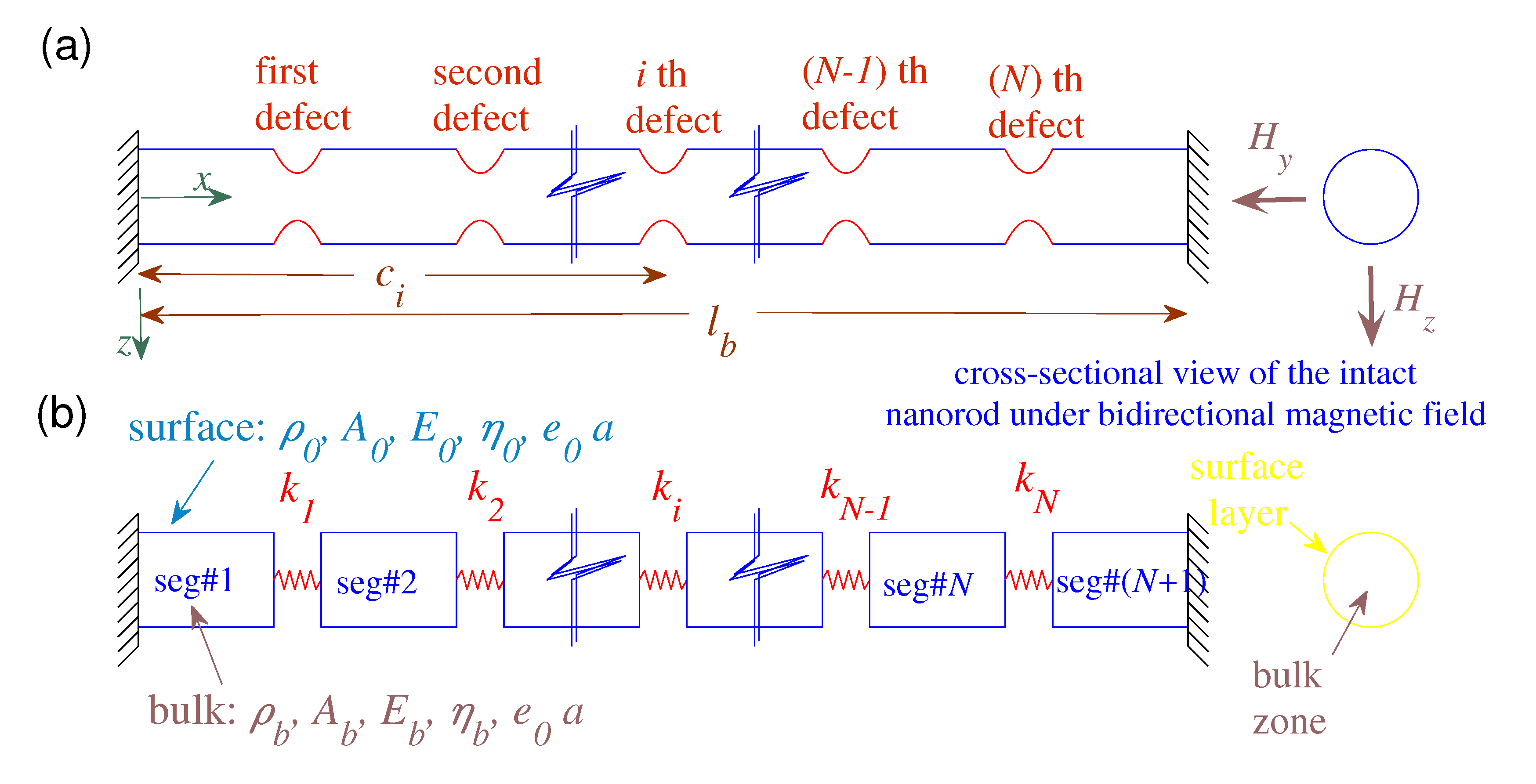
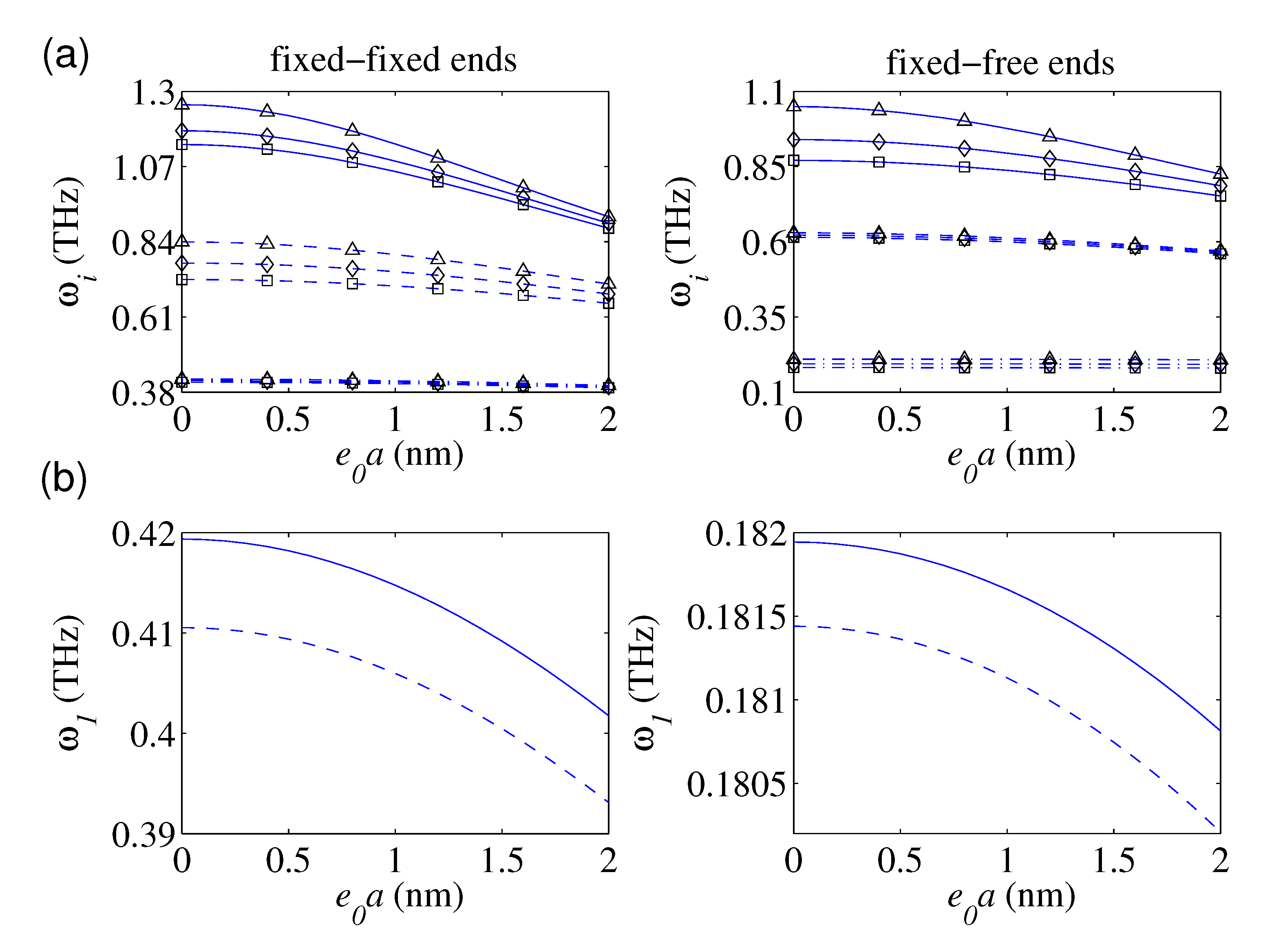

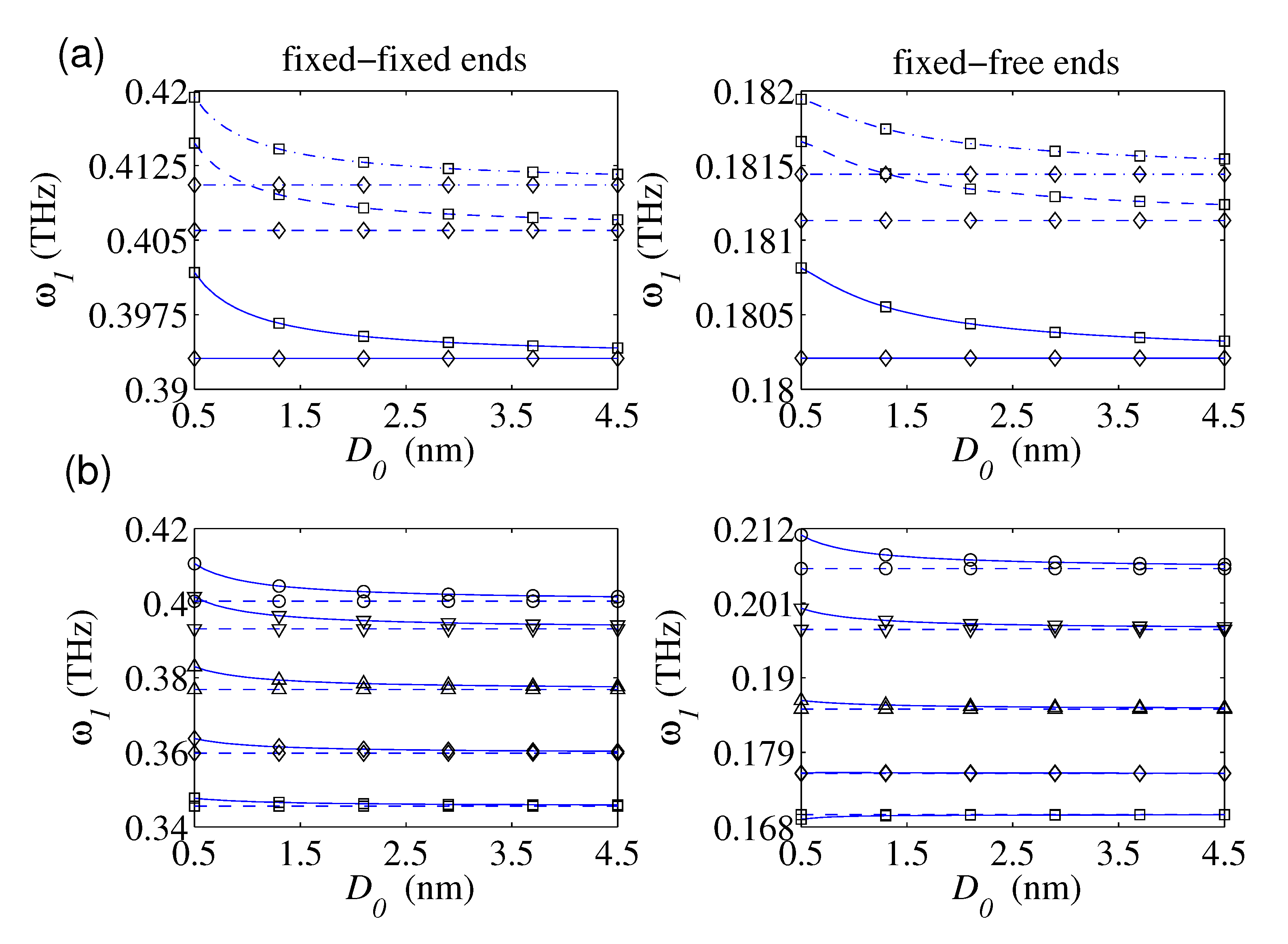
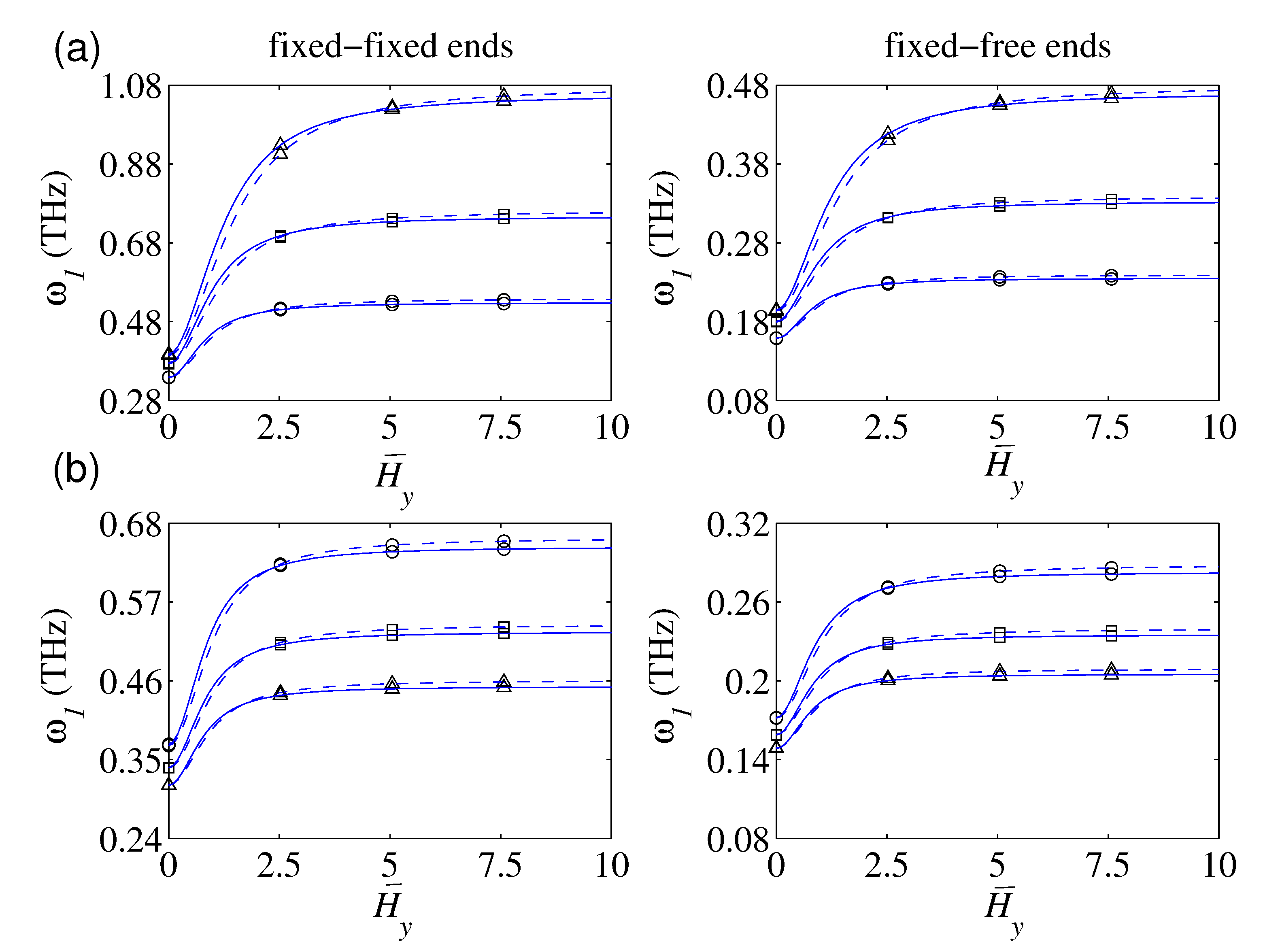
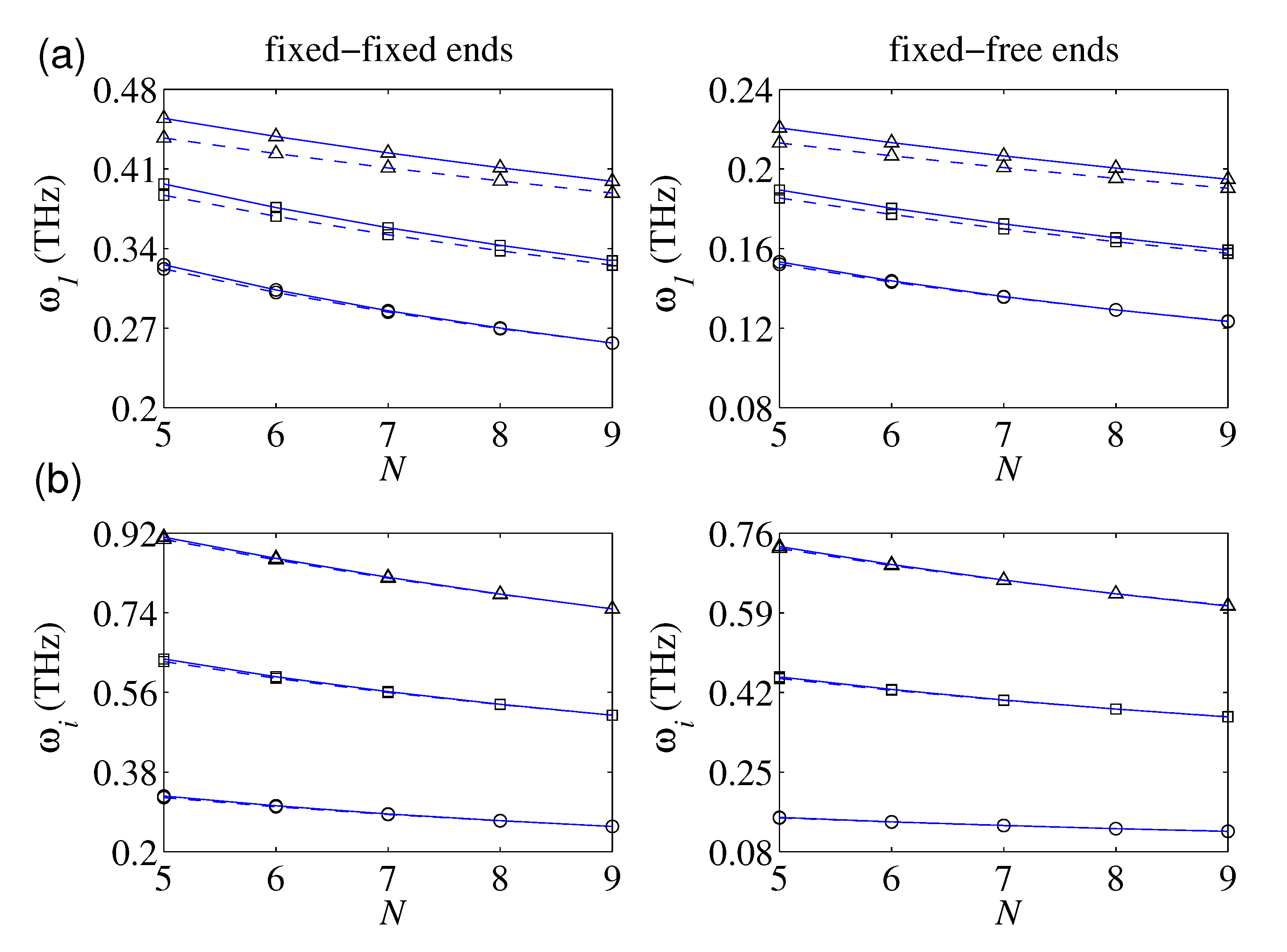
| Conditions | i | 1 | 2 | 3 | 4 | 5 | 6 |
|---|---|---|---|---|---|---|---|
| FIFI | (PS ) | 2.9429 | 6.2236 | 9.3013 | 11.5211 | 14.5149 | 18.1339 |
| [82] | 2.9429 | 6.2236 | 9.3013 | 11.5211 | 14.5149 | 18.1339 | |
| FIFR | (PS) | 1.4278 | 4.5578 | 7.8540 | 10.4472 | 12.8743 | 16.2952 |
| [82] | 1.4278 | 4.5576 | 7.8540 | 10.4486 | 12.8741 | 16.2952 |
| N = 2 | N = 3 | N = 4 | N = 5 | |||||
|---|---|---|---|---|---|---|---|---|
| (nm) | NDSM | NISM | NDSM | NISM | NDSM | NISM | NDSM | NISM |
| 10 | 0.9477 | 1.0204 | 0.8024 | 0.8521 | 0.7073 | 0.7448 | 0.6388 | 0.6683 |
| 2.2301 | 2.0107 | 1.4714 | 1.5521 | 1.3404 | 1.4083 | 1.2307 | 1.2875 | |
| 15 | 0.6341 | 0.6888 | 0.5360 | 0.5736 | 0.4721 | 0.5005 | 0.4262 | 0.4486 |
| 1.5722 | 1.4625 | 0.9856 | 1.0425 | 0.8971 | 0.9458 | 0.8229 | 0.8637 | |
| 20 | 0.4762 | 0.5196 | 0.4023 | 0.4323 | 0.3543 | 0.3769 | 0.3198 | 0.3377 |
| 1.2042 | 1.1430 | 0.7404 | 0.7840 | 0.6737 | 0.7115 | 0.6177 | 0.6495 | |
| 25 | 0.3812 | 0.4170 | 0.3220 | 0.3469 | 0.2835 | 0.3023 | 0.2559 | 0.2708 |
| 0.9730 | 0.9363 | 0.5928 | 0.6281 | 0.5393 | 0.5702 | 0.4944 | 0.5205 | |
| 30 | 0.3178 | 0.3482 | 0.2683 | 0.2896 | 0.2362 | 0.2524 | 0.2132 | 0.2260 |
| 0.8153 | 0.7923 | 0.4941 | 0.5238 | 0.4495 | 0.4757 | 0.4121 | 0.4342 | |
| N = 2 | N = 3 | N = 4 | N = 5 | |||||
|---|---|---|---|---|---|---|---|---|
| (nm) | NDSM | NISM | NDSM | NISM | NDSM | NISM | NDSM | NISM |
| 10 | 0.4173 | 0.4287 | 0.3631 | 0.3756 | 0.3254 | 0.3367 | 0.2974 | 0.3071 |
| 1.1600 | 1.2215 | 1.0413 | 1.0886 | 0.9473 | 0.9867 | 0.8731 | 0.9064 | |
| 15 | 0.2784 | 0.2898 | 0.2421 | 0.2533 | 0.2170 | 0.2267 | 0.1983 | 0.2065 |
| 0.7762 | 0.8216 | 0.6960 | 0.7315 | 0.6327 | 0.6621 | 0.5829 | 0.6077 | |
| 20 | 0.2088 | 0.2189 | 0.1816 | 0.1910 | 0.1628 | 0.1708 | 0.1487 | 0.1555 |
| 0.5828 | 0.6184 | 0.5225 | 0.5507 | 0.4748 | 0.4982 | 0.4374 | 0.4571 | |
| 25 | 0.1671 | 0.1758 | 0.1453 | 0.1532 | 0.1302 | 0.1372 | 0.1190 | 0.1235 |
| 0.4665 | 0.4957 | 0.4181 | 0.4415 | 0.3800 | 0.3994 | 0.3500 | 0.3659 | |
| 30 | 0.1393 | 0.1468 | 0.1211 | 0.1246 | 0.1085 | 0.1025 | 0.0992 | 0.1243 |
| 0.3889 | 0.4136 | 0.3485 | 0.3676 | 0.3167 | 0.3303 | 0.2917 | 0.3127 | |
| = 2 | = 3 | = 4 | = 5 | |||||
|---|---|---|---|---|---|---|---|---|
| NDSM | NISM | NDSM | NISM | NDSM | NISM | NDSM | NISM | |
| 1 | 0.3434 | 0.3610 | 0.4023 | 0.4323 | 0.4456 | 0.4886 | 0.4790 | 0.5354 |
| 0.6216 | 0.6453 | 0.7404 | 0.7840 | 0.8311 | 0.8981 | 0.9031 | 0.9963 | |
| 1.5239 | 1.3700 | 1.5609 | 1.4172 | 1.5947 | 1.4633 | 1.6253 | 1.5082 | |
| 2 | 0.3663 | 0.3726 | 0.4414 | 0.4528 | 0.5016 | 0.5188 | 0.5522 | 0.5756 |
| 0.6447 | 0.6523 | 0.7827 | 0.7968 | 0.8959 | 0.9176 | 0.9927 | 1.0232 | |
| 2.5658 | 2.2804 | 2.5903 | 2.3081 | 2.6141 | 2.3358 | 2.6374 | 2.3633 | |
| 3 | 0.3727 | 0.3758 | 0.4529 | 0.4585 | 0.5189 | 0.5275 | 0.5758 | 0.5875 |
| 0.6506 | 0.6542 | 0.7936 | 0.8002 | 0.9127 | 0.9228 | 1.0162 | 1.0305 | |
| 3.6977 | 3.2780 | 3.7151 | 3.2971 | 3.7322 | 3.3162 | 3.7492 | 3.3353 | |
| 4 | 0.3752 | 0.3770 | 0.4575 | 0.4607 | 0.5259 | 0.5309 | 0.5853 | 0.5922 |
| 0.6529 | 0.6549 | 0.7977 | 0.8015 | 0.9190 | 0.9248 | 1.0251 | 1.0332 | |
| 4.8577 | 4.3023 | 4.8710 | 4.3168 | 4.8842 | 4.3313 | 4.8974 | 4.3458 | |
| = 2 | = 3 | = 4 | = 5 | |||||
|---|---|---|---|---|---|---|---|---|
| NDSM | NISM | NDSM | NISM | NDSM | NISM | NDSM | NISM | |
| 1 | 0.1542 | 0.1599 | 0.1816 | 0.1910 | 0.2022 | 0.2153 | 0.2184 | 0.2352 |
| 0.4407 | 0.4567 | 0.5225 | 0.5507 | 0.5846 | 0.6265 | 0.6343 | 0.6908 | |
| 0.6552 | 0.6752 | 0.7860 | 0.8227 | 0.8888 | 0.9451 | 0.9731 | 1.0512 | |
| 2 | 0.1634 | 0.1656 | 0.1972 | 0.2011 | 0.2245 | 0.2302 | 0.2476 | 0.2552 |
| 0.4614 | 0.4669 | 0.5587 | 0.5687 | 0.6380 | 0.6531 | 0.7054 | 0.7263 | |
| 0.6735 | 0.6800 | 0.8194 | 0.8314 | 0.9398 | 0.9583 | 1.0438 | 1.0696 | |
| 3 | 0.1661 | 0.1671 | 0.2019 | 0.2038 | 0.2315 | 0.2344 | 0.2571 | 0.2610 |
| 0.4671 | 0.4697 | 0.5689 | 0.5737 | 0.6534 | 0.6608 | 0.7266 | 0.7368 | |
| 0.6782 | 0.6812 | 0.8280 | 0.8336 | 0.9531 | 0.9618 | 1.0623 | 1.0745 | |
| 4 | 0.1671 | 0.1677 | 0.2038 | 0.2049 | 0.2344 | 0.2361 | 0.2609 | 0.2633 |
| 0.4692 | 0.4708 | 0.5729 | 0.5757 | 0.6595 | 0.6637 | 0.7350 | 0.7409 | |
| 0.6799 | 0.6817 | 0.8313 | 0.8345 | 0.9582 | 0.9632 | 1.0694 | 1.0763 | |
Publisher’s Note: MDPI stays neutral with regard to jurisdictional claims in published maps and institutional affiliations. |
© 2020 by the authors. Licensee MDPI, Basel, Switzerland. This article is an open access article distributed under the terms and conditions of the Creative Commons Attribution (CC BY) license (http://creativecommons.org/licenses/by/4.0/).
Share and Cite
Kiani, K.; Żur, K.K. Dynamic Behavior of Magnetically Affected Rod-Like Nanostructures with Multiple Defects via Nonlocal-Integral/Differential-Based Models. Nanomaterials 2020, 10, 2306. https://doi.org/10.3390/nano10112306
Kiani K, Żur KK. Dynamic Behavior of Magnetically Affected Rod-Like Nanostructures with Multiple Defects via Nonlocal-Integral/Differential-Based Models. Nanomaterials. 2020; 10(11):2306. https://doi.org/10.3390/nano10112306
Chicago/Turabian StyleKiani, Keivan, and Krzysztof Kamil Żur. 2020. "Dynamic Behavior of Magnetically Affected Rod-Like Nanostructures with Multiple Defects via Nonlocal-Integral/Differential-Based Models" Nanomaterials 10, no. 11: 2306. https://doi.org/10.3390/nano10112306
APA StyleKiani, K., & Żur, K. K. (2020). Dynamic Behavior of Magnetically Affected Rod-Like Nanostructures with Multiple Defects via Nonlocal-Integral/Differential-Based Models. Nanomaterials, 10(11), 2306. https://doi.org/10.3390/nano10112306






